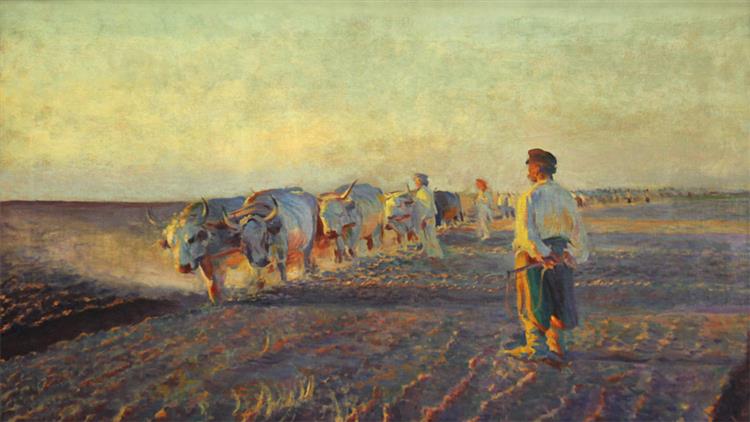Description
The work "Arando in Ukraine" (Plowing in Ukraine) by Leon Wycó? Kowski, painted in 1892, is a prototypical example of rural realism that characterized the Polish artist. This painting evokes a deep connection with the Earth, where the act of Arar not only becomes an agricultural gesture, but also a manifestation of the culture and identity of the Ukrainian people. When observing the work, a composition is perceived that revolves around the central figure of a farmer, who is immersed in the task of tanking the earth, symbolizing the hard work and dedication of those who depend on this work for their subsistence.
The palette used by Wycó? Kowski is rich and vibrant, combining earthly tones and green nuances that reflect the natural environment. The warm colors of the newly plowed soil contrast with the darkest nuances of the sky, suggesting an imminent change or a storm. This color choice not only establishes a dialogue between the earth and the sky, but also hints the emotional connection that the farmer has with his surroundings. The use of color also highlights the luminosity of Ukraine, a country with vast extensions of fields and a deep agricultural heritage.
The treatment of the peasant figure is remarkable; Its position and the way in which it supports the plow utensils convey a sense of effort and resignation, along with a certain dignity. Wycó? Kowski uses a naturalism that highlights the physical characteristics of agricultural work, from the texture of the peasant's clothing to the force that emanates from his figure. Although the work represents a single man in his work, you can feel the presence of the broader agricultural community, which invites the viewer to reflect on rural life in Ukraine and the importance of teamwork.
The style of Wycó? Kowski is influenced by impressionism and realism, which translates into meticulous attention to detail and in the search to capture the light and the atmosphere of the moment. This work is not just a representation of the Arar Act; It is a portrait of the agrarian ethos, which manifests itself in the connection of man with the earth. In addition, its focus on rural life can be seen as a comment on the social and economic transformation that was lived in Eastern Europe at the end of the 19th century, where tensions between modernity and agrarian traditions began to emerge.
"Arando in Ukraine" is also significant in the context of the history of Polish art, where the representation of peasant life became a relevant theme during the movement of modern painting. Wycó? Kowski, as one of the outstanding artists of his time, knew how to capture not only the landscape, but also the spirit of a people who work tirelessly to sustain their culture. His work is part of an artistic legacy that cares about the dignity of work and the reliable representation of everyday life. In conclusion, "Arando in Ukraine" is not only a painting that illustrates an agricultural scene, but invites spectators to immerse themselves in the deep sense of identity and belonging that this work represents for the Ukrainian people.
KUADROS ©, a famous paint on your wall.
Hand-made oil painting reproductions, with the quality of professional artists and the distinctive seal of KUADROS ©.
Art reproduction service with satisfaction guarantee. If you are not completely satisfied with the replica of your painting, we refund your money 100%.

